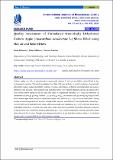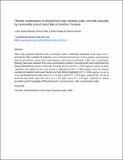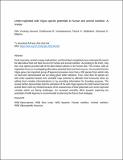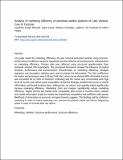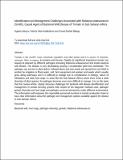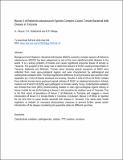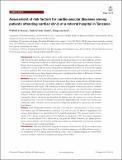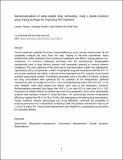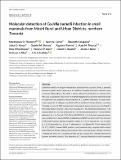Research Articles [LISBE]: Recent submissions
Now showing items 541-560 of 886
-
Quality Assessment of Formulated Osmotically Dehydrated Cashew Apple (Anacardium occidentale L.) Slices Dried using Hot air and Solar Driers
(International Journal of Biosciences, 2020-12-28)Cashew apples are rich in phytochemicals particularly vitamin C and yet are highly underutilized in low technological countries. This study investigated the effect of drying methods on quality attributes of osmotically ... -
Fluoride contamination of selected food crops, domestic water, and milk consumed by communities around mount Meru in Northern Tanzania.
(Taylor & Francis Online, 2021-01-24)This study assessed fluoride levels in domestic water, commonly consumed food crops, cow's, and human milk. Samples of vegetables were collected from farmer's home gardens, green banana from local markets, maize flour, and ... -
Under-exploited wild Vigna species potentials in human and animal nutrition: A review
(Elsevier, 2018-09)Food insecurity, protein-energy malnutrition, and food-feed competition have motivated the search for alternative food and feed sources for human and animal nutrition. According to the FAO, only four crop species provide ... -
Analysis of marketing efficiency of processed sardine products of Lake Victoria: Case of Tanzania
(Taylor & Francis Online, 2019-05-27)The paper tested the marketing efficiency of Lake Victoria processed sardines using structure-performance and efficient-structure hypotheses and the influence of socioeconomic characteristics on marketing efficiency. Primary ... -
Seasonal variations in the availability of fodder resources and practices of dairy cattle feeding among the smallholder farmers in Western Usambara Highlands, Tanzania.
(Springer Nature Switzerland AG., 2018-10-01)The aim of this study was to assess the seasonal effects on quantity and quality of fodder resources and associated utilization practices among smallholder dairy farmers in Western Usambara Highlands (WUHs) in Tanzania. ... -
Phytochemical Analysis of across East Africa Reveals Three Chemotypes that Influence Its Use as a Pesticidal Plant.
(MDPI, 2019-12-12)is a plant species chemically characterized by the presence of entomotoxic rotenoids and used widely across Africa as a botanical pesticide. Phytochemical analysis was conducted to establish the presence and abundance of ... -
Identification and Management Challenges Associated with Ralstonia solanacearum (Smith), Causal Agent of Bacterial Wilt Disease of Tomato in Sub-Saharan Africa.
(Science Alert, 2017)Tomato is the world's most consumed vegetable crop after potato and it is source of vitamins, minerals, fiber, lycopene, β-carotene and income. Despite its significant importance tomato can heavily be attacked by different ... -
Biovar 2 of Ralstonia solanacearum Species Complex Causes Tomato Bacterial Wilt Disease in Tanzania
(Science Alert, 2020-03)Background and Objective: Bacterial wilt disease (BWD) caused by complex species of Ralstonia solanacearum (RSSC) has been categorized as one of the most significant plant diseases in the world. It is a serious problem ... -
Classification and characterisation of livestock production systems in northern Tanzania.
(PLOS ONE, 2020-12-30)Livestock keepers in sub-Saharan Africa face a range of pressures, including climate change, land loss, restrictive policies, and population increase. Widespread adaptation in response can lead to the emergence of new, ... -
Physicochemical Properties, Fatty Acid Composition, and the Effect of Heating on the Reduction of Cyclopropenoid Fatty Acids on Baobab (Adansonia digitata L.) Crude Seed Oil
(Hindawi, 2020-12-14)The baobab seed oil has been consumed by humans due to its medicinal and nutrient values for many years. However, the consumption of baobab seed oil has been perceived by different communities as a health risk caused by ... -
Assessment of risk factors for cardiovascular diseases among patients attending cardiac clinic at a referral hospital in Tanzania
(AME Publishing Company, 2019-04-12)Background: Mortality and morbidity due to cardiovascular diseases (CVDs) are escalating worldwide, with disproportionately significant worse outcomes in developing countries, due to rapid health and nutrition transition ... -
Nanoencapsulation of water-soluble drug, lamivudine, using a double emulsion spray-drying technique for improving HIV treatment
(Springer Nature Switzerland AG., 2013-10-22)Current treatments available for human immunodeficiency virus, namely antiretrovirals, do not completely eradicate the virus from the body, leading to life-time commitment. Many antiretrovirals suffer drawbacks from ... -
Larvicidal activity of Hypoestes forskaolii (Vahl) R. Br root extracts against Anopheles gambiae Giless.s, Aedes aegypti L, and Culex quinquefasciatus Say
(Dove Press, 2019-04-26)Aim: This study aimed to evaluate larvicidal activity of Hypoestes forskaolii R. Br root extract against 3rd instar Anopheles gambiae, Aedes aegypti, and Culex quinquefasciatus. Methods: A protocol developed by the World ... -
Molecular detection of Coxiella burnetii infection in small mammals from Moshi Rural and Urban Districts, northern Tanzania.
(John Wiley & Sons Ltd, 2020-12-05)Coxiella burnetii is an obligate intracellular bacterium that causes Q fever, a zoonotic disease of public health importance. In northern Tanzania, Q fever is a known cause of human febrile illness, but little is known ... -
The effect of land-use systems on greenhouse gas production and crop yields in Wakiso District, Uganda
(Elsevier B.V., 2020-12-16)Land-use systems are among the leading sources of anthropogenic GHG into the atmosphere; driving global warming, climate change, and associated extreme weather events. To estimate GHGs from the land-use systems, we measured ... -
Factors associated with infectious bursal disease vaccination failure in Dar es salaam, Tanzania
(Journal of Veterinary Medicine and Animal Health, 2020-09)Infectious bursal disease (IBD) is a viral infection that affects young chicks. The IBD outbreaks in vaccinated chickens are reported in Tanzania frequently. The current study was conducted to find out the possible causes ... -
Recovery of acetyl cholinesterase inhibition by Methanolic Bark Extract of Acacia nilotica from Organophosphate Pesticides Exposure in mice model
(International Journal of Biosciences, 2020-01-15)Organophosphates (OPs) pesticides are reported to cause acute poisoning because of their ability to inhibit acetyl cholinesterase enzyme (AChE). Available antidotes drugs are atropine sulfur, Pralidoxime (2-pyridine ... -
Preferred resting surfaces of dominant malaria vectors inside different house types in rural south-eastern Tanzania
(Springer Nature, 2020-01-15)Background: Malaria control in Africa relies extensively on indoor residual spraying (IRS) and insecticide-treated nets (ITNs). IRS typically targets mosquitoes resting on walls, and in few cases, roofs and ceilings, using ... -
Evidence of Chikungunya but not Dengue Virus Circulating among Febrile Patients during Low Transmission Period in Morogoro Municipality, Tanzania
(International Journal of TROPICAL DISEASE & Health, 2020-02-26)Background: There is currently sufficient evidence available indicating that dengue and chikungunya viruses could be among the causes of fever in Tanzania. Overlapping clinical manifestations of chikungunya and dengue with ... -
Creating mosquito-free outdoor spaces using transfuthrin-treated chairs and ribbons
(Springer Nature, 2020-03-10)Background: Residents of malaria-endemic communities spend several hours outdoors performing diferent activities, e.g. cooking, story-telling or eating, thereby exposing themselves to potentially-infectious mosquitoes. ...

